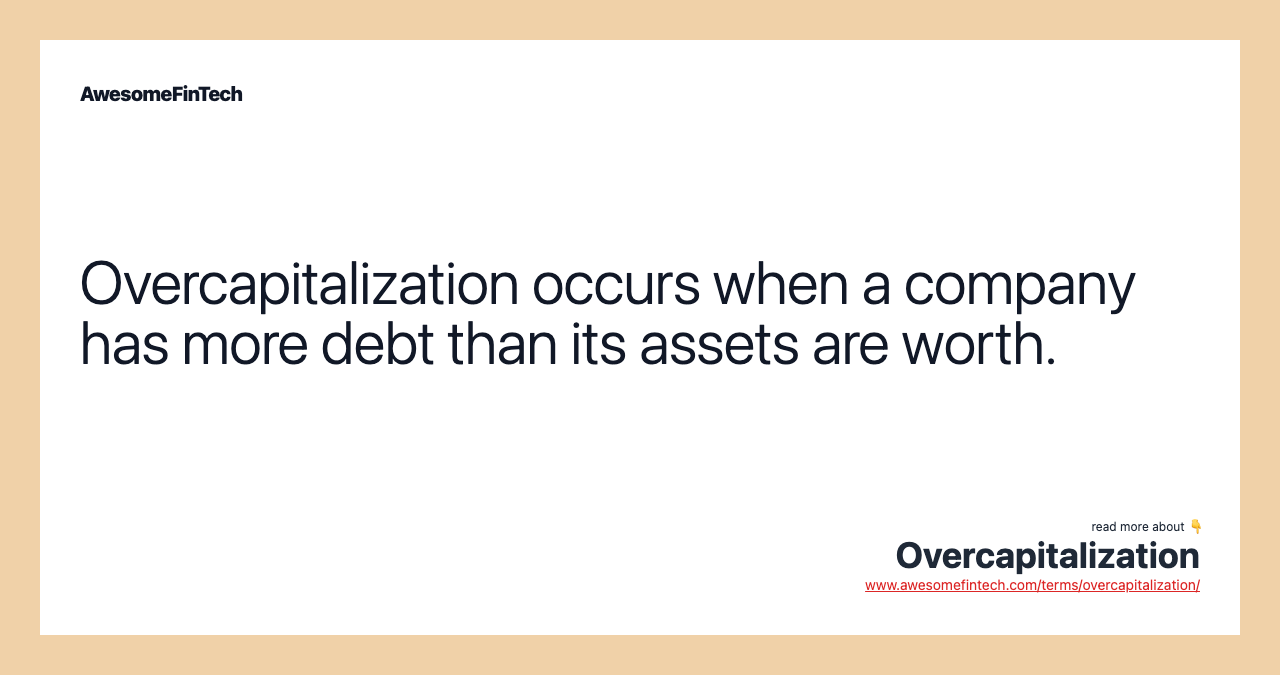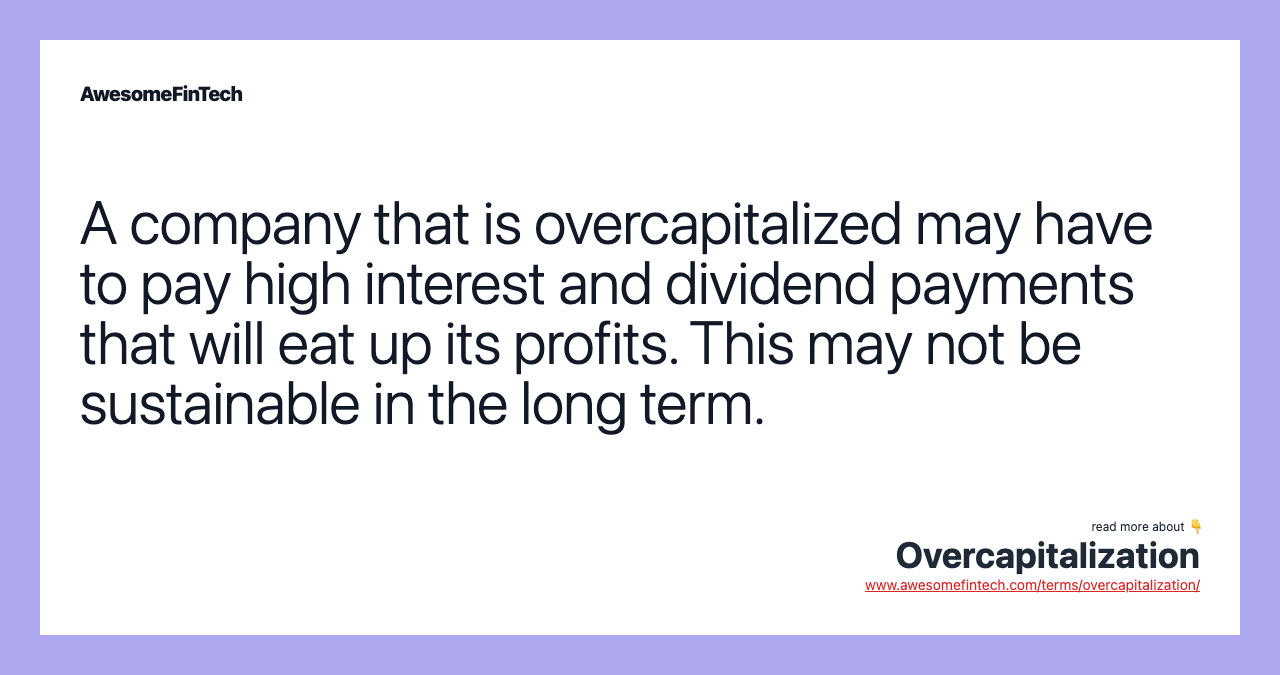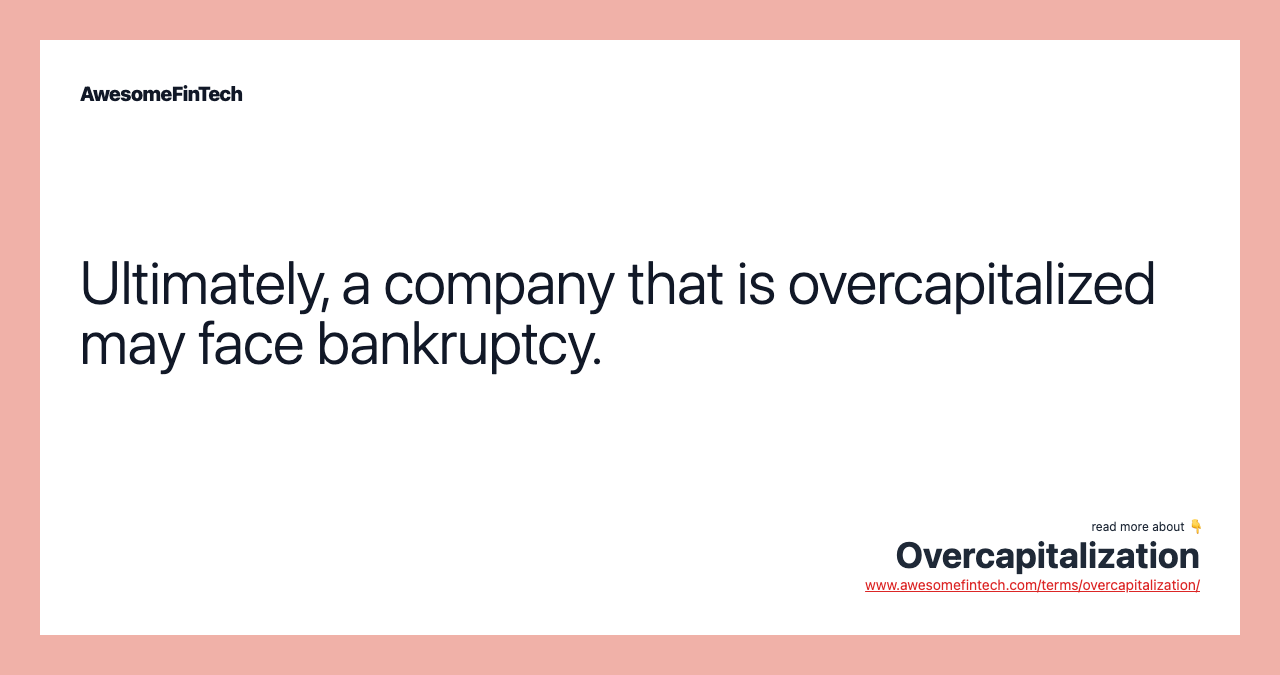Overcapitalization
Overcapitalization occurs when a company has issued more in debt and equity than its assets are worth. An example of overcapitalization is the following: Company ABC is a construction company earning $200,000 with a required rate of return of 20%. The fairly capitalized capital is $200,000/20% = $1,000,000 If we assume that instead of $1,000,000, ABC company uses $1,200,000, as its capital. To escape the situation, the company may need to reduce its debt load or buy back shares to reduce the company's dividend payments. The rate of earnings will be $200,000/$1,200,000 = 17% Due to overcapitalization, the rate of return has dropped from 20% to 17%. One advantage of being overcapitalized is that the company has excess capital or cash on the balance sheet. The heavy debt burden and associated interest payments that an overcapitalized entity carried will be a strain on profits and reduce the amount of retained funds the company has to invest in research and development (R&D) or other projects.

What Is Overcapitalization?
Overcapitalization occurs when a company has issued more in debt and equity than its assets are worth. If this is the case, the market value of the company is less than the total capitalized value of the company. An overcapitalized company might be paying more in interest and dividend payments than it can sustain in the long term.



Understanding Overcapitalization
The heavy debt burden and associated interest payments that an overcapitalized entity carried will be a strain on profits and reduce the amount of retained funds the company has to invest in research and development (R&D) or other projects. To escape the situation, the company may need to reduce its debt load or buy back shares to reduce the company's dividend payments. Restructuring the company's capital is a solution to this problem.
An example of overcapitalization is the following:
Company ABC is a construction company earning $200,000 with a required rate of return of 20%.
The fairly capitalized capital is $200,000/20% = $1,000,000
If we assume that instead of $1,000,000, ABC company uses $1,200,000, as its capital. The rate of earnings will be $200,000/$1,200,000 = 17%
Due to overcapitalization, the rate of return has dropped from 20% to 17%.
One advantage of being overcapitalized is that the company has excess capital or cash on the balance sheet. This cash can earn a nominal rate of return and increase the company's liquidity. Also, the excess capital means that the company will have a higher valuation and can claim a higher price in the event of an acquisition or merger. Lastly, additional capital can fund expenditures such as R&D.
Undercapitalization
The opposite of overcapitalization is undercapitalization. Undercapitalization occurs when a company has neither sufficient cash flow nor the access to credit that it needs to finance its operations. The company may not be able to issue stock on the public markets because the company does not meet the requirements, or the filing expenses are too high. Essentially, the company cannot raise capital to fund itself, its daily operations, or any expansion projects. Undercapitalization most commonly occurs in companies with high start-up costs, too much debt, and insufficient cash flow. Undercapitalization can ultimately lead to bankruptcy.
Overcapitalization In the Insurance Market
Overcapitalization is also a term used in the insurance market. In this context, when the supply of policies exceeds the demand for policies, this creates a soft market and causes insurance premiums to decline until the market stabilizes. Policies purchased in times of low premium levels can reduce an insurance company's profitability.
Related terms:
Accounting
Accounting is the process of recording, summarizing, analyzing, and reporting financial transactions of a business to oversight agencies, regulators, and the IRS. read more
Acquisition
An acquisition is a corporate action in which one company purchases most or all of another company's shares to gain control of that company. read more
Asset
An asset is a resource with economic value that an individual or corporation owns or controls with the expectation that it will provide a future benefit. read more
Balance Sheet : Formula & Examples
A balance sheet is a financial statement that reports a company's assets, liabilities and shareholder equity at a specific point in time. read more
Bankruptcy
Bankruptcy is a legal proceeding for people or businesses that are unable to repay their outstanding debts. read more
Capitalization
Capitalization is an accounting method in which a cost is included in the value of an asset and expensed over the useful life of that asset. read more
Capital Structure
Capital structure is the particular combination of debt and equity used by a company to funds its ongoing operations and continue to grow. read more
Cash Flow
Cash flow is the net amount of cash and cash equivalents being transferred into and out of a business. read more
Corporate Finance
Corporate finance is the division of finance that deals with how corporations address funding sources, capital structuring, and investment decisions. read more